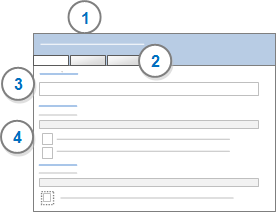
You can export a table of all the sources that have been coded at a node, including information about the number of references and percentage of coding. You can export this summary in the following formats:
Microsoft Excel Worksheet (.xlsx, .xls)
Plain text (.txt)
Microsoft Word (.docx, .doc)
Rich text (.rtf)
PDF (.pdf)
To export a node summary:
In List View, select the node you want to export.
On the External Data tab, in the Export group, click Export, and then click Export <Item>. The item name varies, depending on the node type selected.

The Export Options dialog box opens.
From the Export list, select Summary View.
To display the exported node after exporting, select the Open on Export check box.
Click OK. The Save As dialog box opens.
The exported file is saved to your default location for exported files, you can choose a different location if necessary.
In the File name box, review the name that NVivo proposes for the exported file, and change it if necessary.
In the Save as type box, choose the file format for the exported file.
Click Save.
NOTE If you export a parent node with node aggregation turned on, the exported node includes content coded at the parent and content coded at all of the child nodes.
You can export all the references in a node (including text content and information about the media content). You can export the references in the following formats:
Plain text (.txt)
Microsoft Word (.docx, .doc)
Rich text (.rtf)
PDF (.pdf)
In List View, select the node you want to export.
On the External Data tab, in the Export group, click Export, and then click Export <Item>. The item name varies, depending on the node type selected.

The Export Options dialog box opens.
From the Export list, select Reference View.
Select the required options—for more information refer to Export Options.
To display the exported node after exporting, select the Open on Export check box.
Click OK. The Save As dialog box opens.
The exported file is saved to your default location for exported files, you can choose a different location if necessary.
In the File name box, review the name that NVivo proposes for the exported file, and change it if necessary.
In the Save as type box, choose the file format for the exported file.
Click Save.
NOTE If you export a parent node with node aggregation turned on, the exported node includes content coded at the parent and content coded at all of the child nodes.
You can export the entire content of a node to make a 'mini website'—this is a great way to share your findings (including audio and video clips) with colleagues who don't have NVivo.
In List View, select the node you want to export.
On the External Data tab, in the Export group, click Export, and then click Export <Item>. The item name varies, depending on the node type selected.

The Export Options dialog box opens
From the Export list, select Entire Content.
Select the required options—for more information refer to Export Options.
To see the exported HTML pages, select the Open on Export check box.
Click OK.
NOTE
The node is exported as a series of web pages that are stored in your 'My Documents' folder. The 'home' page has the same name as the exported node (for example, adapting to climate change.htm). You can open this file to access the 'mini website'.
If you want to move the web pages, make sure you copy all the .HTM files to the new location.
If you export a parent node with node aggregation turned on, the exported node includes content coded at the parent and content coded at all of the child nodes.
When you open the home page for an exported node you will see a web page displaying node summary:

1 Displays the node name
2 Click a tab to content of a selected type (text, video, audio, pictures or datasets)
3 The overview section describes the type of node
4 The content section displays the source references that have been coded at the node. Click View Details to see the content.
NOTE You may notice a security message a the top of the window. If you want to play video or audio material, you need to click the message and allow blocked content to be displayed.
You can export the node structure as it appears in List View—click the plus ![]() or minus
or minus ![]() symbols to expand or collapse the hierarchy as required.
symbols to expand or collapse the hierarchy as required.
You can export the node list in the following formats:
Microsoft Excel Worksheet (.xlsx, .xls)
Plain text (.txt)
Microsoft Word (.docx, .doc)
Rich text (.rtf)
PDF (.pdf)
In List View, select the node you want to export.
On the External Data tab, in the Export group, click Export, and then click Export List

The Save As dialog box opens.
The exported file is saved to your default location for exported files, you can choose a different location if necessary.
In the File name box, review the name that NVivo proposes for the exported file, and change it if necessary.
In the Save as type box, choose the file format for the exported file.
Click Save.